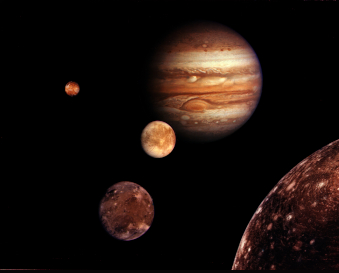- Series:Astronomy, Transcript English
Genesis 1:16b
“He made the stars also…”
 Somewhere, hidden deep in a box in a storeroom, is a book about the planets, written and presented to me by a TV astronomer in Britain. In the section about Jupiter, it informs me that the Solar System’s largest planet has 10 moons. Since that book was published, in the early 1970s, they have found a few more. As I write this script, an article in New Scientist informs me that Jupiter has 79 known moons.
Somewhere, hidden deep in a box in a storeroom, is a book about the planets, written and presented to me by a TV astronomer in Britain. In the section about Jupiter, it informs me that the Solar System’s largest planet has 10 moons. Since that book was published, in the early 1970s, they have found a few more. As I write this script, an article in New Scientist informs me that Jupiter has 79 known moons.
The article also said that 5 recently discovered moons have just been given official names.
It was interesting to read how the names are assigned. The moon’s discoverer has the right to suggest a name, and the International Astronomical Union (IAU) decides on the suitability of the name. Greco-Roman mythology is mined for the names of the Jovian system. All Jupiter’s moons are named after legendary lovers or descendants of Jupiter/Zeus. One extra nugget, however, that I had not previously known is this: If the moon’s name ends with an “a”, it means that it orbits retrograde, compared to the normal orbital direction of planets and moons.
How did some moons manage to orbit in a retrograde manner in any case? If all these objects had condensed from solar dust, as deep-time astrophysicists suggest, angular momentum would require that they all orbit in the same direction. The existence of moons like Europa, Amalthea and newly named Pandia is a huge problem for evolutionary ideas about the planets.
Prayer: Lord God, everything that we learn about Your universe causes us to marvel more and more at Your greatness and how it all brings glory to Your Name. Amen.
Author: Paul F. Taylor
Ref: Crane, L. (2019), Five of Jupiter’s newly discovered moons have been given names, < https://www.newscientist.com/article/2214382-five-of-jupiters-newly-discovered-moons-have-been-given-names/ >, accessed 8/31/2019. Image: Jupiter and some moons, Public Domain image.
© 2020 Creation Moments. All rights reserved.
